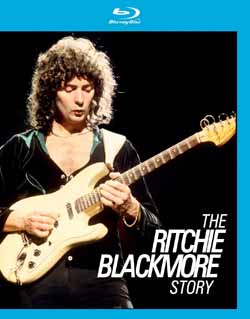The Ritchie Blackmore Story lifts the veil on the mystique surrounding one of rock’s mightiest axe men. With Blackmore himself on board to guide the narrative, the viewer learns how the elusive guitarist got his start, his take on the Deep Purple and Rainbow years, and his current work and life with wife Candace Night. Although there have been mini documentaries and pieces made about Deep Purple, this is more authoritative piece that, while missing certain key elements — perhaps a little more on Blackmore’s love-hate relationships with Ian Gillan and Ronnie James Dio — opens the door a little winder into the world of Richie Blackmore.
No good documentary is complete without the obligatory testimonial, so right out the gate, there’s Steve Lukather, Brain May, Joe Satriani, Gene Simmons, Steve Vai, Lars Ulrich, David Coverdale, Phil Collen and Ian Anderson praising Blackmore’s mastery. Blackmore then steps in and we go back to the very beginning and how, as a youngster, he aspired to become a great guitar player. It’s fascinating to hear Blackmore talk about it because he’s never been one to give career-spanning interviews. Of course, after playing with any number of bands and backing the likes of Screaming Lord Sutch, Gene Vincent and Jerry Lee Lewis, his meeting with Deep Purple keyboardist Jon Lord is what proved to be a turning point.
From Deep Purple (a name the guitarist suggested because of his grandmother loved the Peter DeRose song) onward, Blackmore’s career is marked by key albums he’s played on over the past five decades. After Deep Purple’s initial success with “Hush,” the guitarist reveals it was after seeing Robert Plant with Led Zeppelin that he decided the band needed a new singer, and thus Gillan, who would eventually become Blackmore’s foil, became Deep Purple’s singer. The sound got harder, Blackmore got wilder and Deep Purple, along with Black Sabbath and Led Zeppelin, came to be considered the progenitors of hard rock and heavy metal.
Rainbow receives equal screen time, after Blackmore splits from Purple due to their new “funkier” direction. This is where, as the documentary seems to bring out, Blackmore took centerstage, leading the band through its various incarnations and musical styles. He explains that Dio left the band because of a magazine cover, but at the same time, he also wanted to Rainbow to adopt a more commercial sound. Dio’s replacement, Graham Bonnet did a bang-up job at getting a hit for Rainbow with “Since You’ve Been Gone,” but lost the gig because of his hair. Joe Lynne Turner had the hair and the hits (Blackmore calls “Street Of Dreams,” the “ultimate Rainbow song”), but then Purple reunited in 1984, and Rainbow was put out to pasture (Although Turner would later join Purple for an album).
Although Blackmore expresses satisfaction with Perfect Strangers, he makes it clear that he and Gillan were still having issues. Turner was recruited for a Purple album, but Gillan came back one more album and tour before a showdown involving a plate spaghetti led Blackmore’s final exit from the band. He would go on to make a final Rainbow album, and then, as the story goes, he switched gears completely and decided to form Blackmore’s Night with wife Candice. He’s stayed the course since, producing nine studio albums with compromising his musical integrity.
The most exciting thing about The Richie Blackmore Story is to see and hear Blackmore tell it. And now that’s he’s spoken up, speculation is high as to what could happen next. He’s already booked gigs with an unknown band of players for the Summer 2016 to “rock” out a bit. Deep Purple’s April induction into the Rock and Roll Hall of Fame has also led many to wonder if the elusive guitarist will show up for the honor, let alone play with his former band mates. As you’ll learn watching The Richie Blackmore Story, the man is as unpredictable as he is ornery, dark, funny and a complete virtuoso of his instrument. He’s also very human and apparently content with where his life has been and where it’s at now.
~ Shawn Perry




















